It’s a battle, being a woman in an Arab country, but perhaps the dire conditions makes us fighters. Since January 25, so many foreign reporters have waxed on about the awakening of Arab women in the Arab Spring; and how the revolutions liberated us/made us wake up and smell the coffee/made us throw off our headscarves and run happily through the meadows.
This, in my opinion, is crap. When you look at the videos and photos of the eighteen days of Tahrir, you’ll see Egyptian women side by side with men in the thick of battles, some even at the front lines, braving tear gas and live bullets. We participated as Egyptians first, not as women, in January 25. And it’s incredibly patronizing to assume we ‘became’ liberated; 1. as if it was a revolution led by men that awakened and inspired us women 2. as if women were living in caves and making mud paintings before the revolution.
the Arab women I’ve met are some of the fiercest women in the world with sincere dedication to their work, cause and sense of identity. We didn’t experience an ‘awakening’ since the revolution; but we’ve definitely had to fight harder.
The last two years’ stories of horrific sexual and physical violence against women in Tahrir and many other depressing news could very easily break your will, change your mind about a woman’s place in protests and in Egypt as a citizen with equal rights. But then I think of these remarkable women and I am reminded of their strength, creativity and perseverance.
There are many powerful, brilliant Arab women, including several in the graffiti scene. Graffiti is a dangerous cause as it is, and with perpetual violence against women in Egypt, you’d think female graffiti artists would be too intimidated to work on the city streets. But they’re not; they’re young, tough, talented and just as worthy of recognition as their male counterparts.
Alexandrian painter and street artist Aya Tarek is considered by many of her peers to be one of the pioneers of graffiti in Egypt. She holds her ground against her male contemporaries, and has exhibited recently in Germany as well as Beirut. Aya appeared in Microphone, Ahmed Abdalla’s brilliant 2010 film about the underground art scene in Alexandria. She is the first graffiti artist in Egypt to appear in a feature film not only playing herself but also correctly representing the graffiti scene in Egypt.
Hend Kheera is the first Egyptian graffiti artist to be profiled by Rolling Stone. Her work has a tough, extreme and honest quality to it, and there’s nothing stereotypically feminine about her aesthetics. Hend made stencils in Mogamaa and around Tahrir during sit-ins in 2011. She participated in an anti-sexual harassment campaign by spraying the stencil ‘Warning! Don’t touch or castration awaits you!’. The stencil was shocking and provocative, compelling some bystanders to even berate Hend for making it, a surefire sign that her message was powerful and effective.
Hanaa El Degham’s mixed art mural on the Lycee wall is to this date one of the most astounding street artworks I have seen in Egypt. She worked several layers over many days, combining barely finished paintings with stencils and newspaper collages. If you looked closely at the newspaper clippings, you’d find them completely spot-on and appropriate for the beautiful social commentary she was making by portraying the poorest of Egyptians carrying gas cylinders on their heads. A women fully clad in black niqab carries a gas cylinder with ‘Change’ sprayed on it. That visual in itself has so much to say.
Hanaa also worked for days with Ammar Abo Bakr and other painters on the Mohamed Mahmoud martyrs’ mural, adding frames and lotus flowers to several of the martyrs’ portraits.
I’d seen Bahia Shehab’s stencils around Zamalek and Tahrir for months, but it was only until I watched her inspiring Tedx talk on YouTube when I made the connection. Bahia spoke beautifully and powerfully of fighting for social and political justice through art. Her stencil below is one of my favourite pieces, a stencil I spotted on the bleak concrete wall of Mansour Street. When you see such an inspiring and pretty quote on a grotesque concrete military construction, you regain hope; at least in the power and potential of art.
There’s also Laila Magued, who works tirelessly day and night alongside Mohamed El Moshir and Ammar Abo Bakr in completing murals like this fantastic one on Sheikh Rihan Street, and there’s Mira Shihadeh who paints messages against sexual harassment, and draws crying faces on the streets of Cairo, with the simple message ‘Why’. I’m sure there are many other women to follow suit soon.
I am privileged to have met most of these women and watch them work. It takes a certain fierceness to persevere in creating unique, inspiring street art under the volatile and unpredictable conditions of the Egyptian streets.
Graffiti has also paid tribute to the women of Egypt, whether by honoring them like Alaa Awad’s pharaonic mural or by paying tribute to their bravery in battle like Zeft’s poster, or defending their rights to equality.
Nooneswa (Noon El Neswa) is a collective of activists that uses graffiti to raise awareness about women’s rights and to lobby for gender equality. Noon El Neswa organised street campaigns where stencils featured Laila Mourad, Soaad Hosny and other iconic women of the Egyptian cinema, and slogans included film quotes or simple demands for equality. Nooneswa is the first collective of its kind to focus solely on women’s issues and use graffiti to raise awareness on the streets of Cairo. Their ‘Don’t Label Me’ design has since appeared in Tunisia, replicated by feminist activists there.
This graffiti on Mohamed Mahmoud Street paid tribute to the Uprising of Women in the Arab World, an online platform with over 80k followers that promotes Arab women’s rights using provocative and personal messages/photos of women.
This stencil on the wall of AUC’s Greek Campus is my favourite: instead of man protecting woman, this visual has the woman rescuing and protecting the man in battle. A brilliant testimony to the fierceness and loyalty of women in protest.
The stencils below are all tributes to the fighting spirit of Egypt’s women by Keizer, Zeft and Amr Nazeer, X4SprayCans and Ammar Abo Bakr, who paid tribute to Samira Ibrahim with a text that compared her to Aliaa El Mahdy. Abo Bakr described Samira Ibrahim as the true hero:
‘Samira Ibrahim: 25 years old. She was stripped and forcefully given a virginity testing in front of military officers and soldiers. She vowed not to stay silent and pursued legal action against them. no attention, no public interest, no media coverage, no one cares.
Aliaa El Mahdy. 20 years old. Stripped and revealed her whole body of her own free will, media and public went crazy, her nude photo was viewed almost 3 million times and no less than 50 articles and several tv shows about her.
A salute of respect to Samira Ibrahim, daughter of Upper Egypt.’

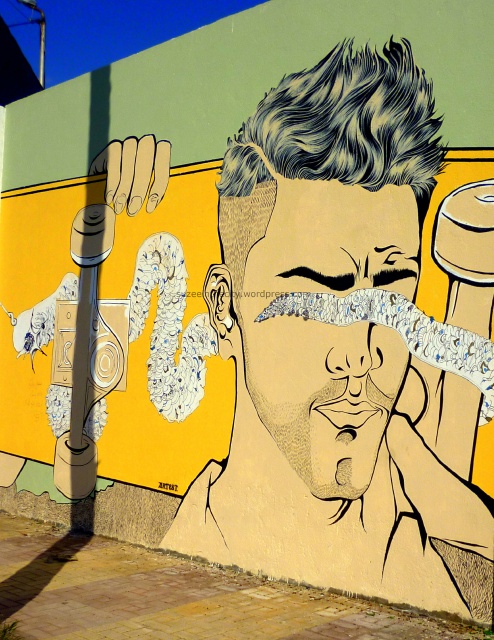
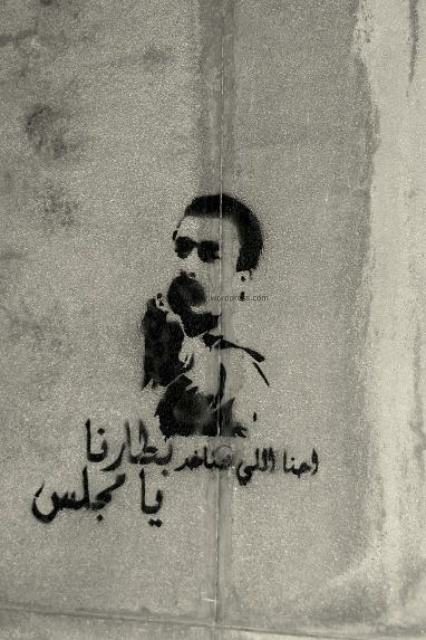
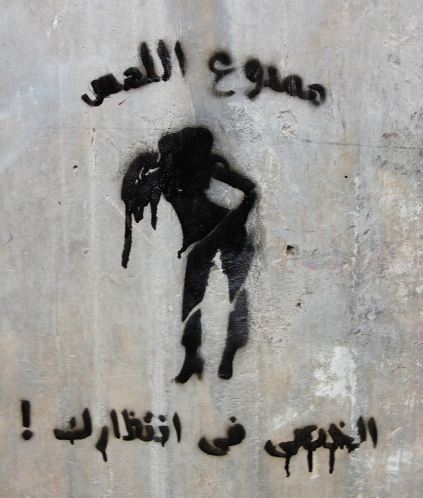
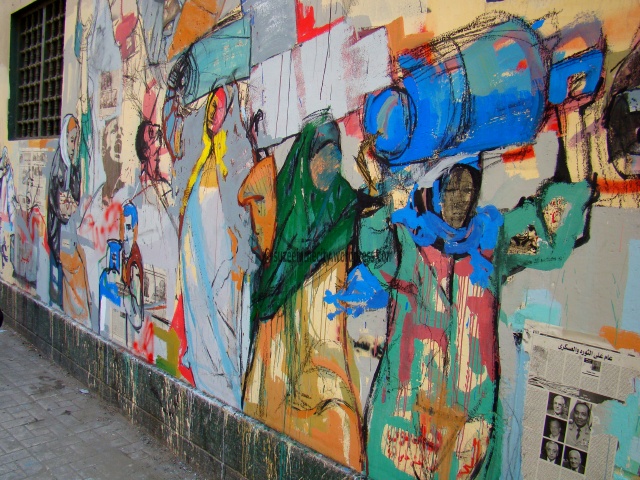
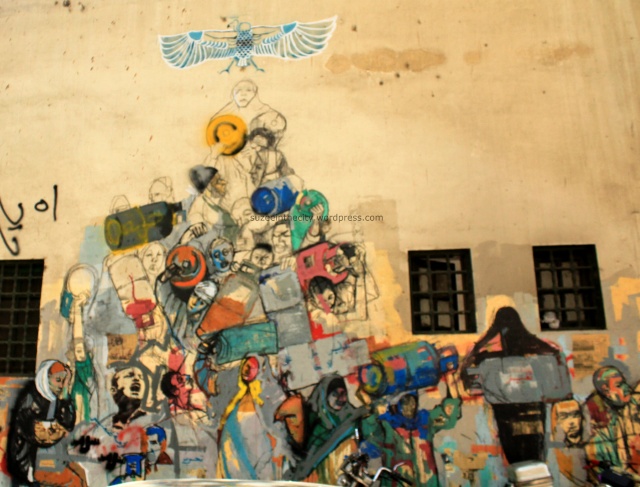

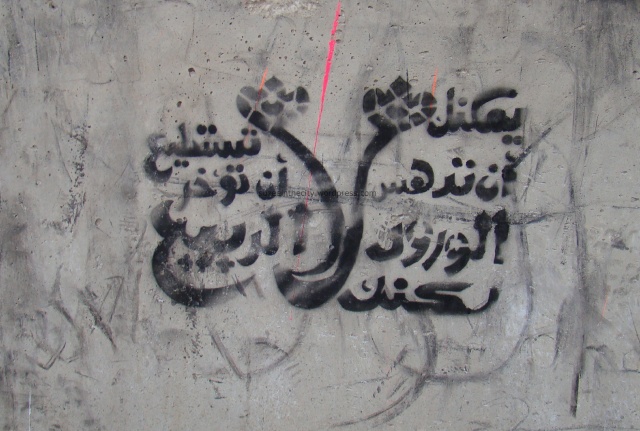

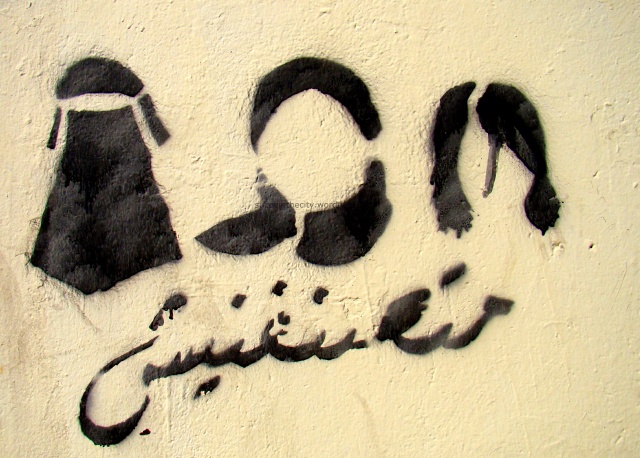
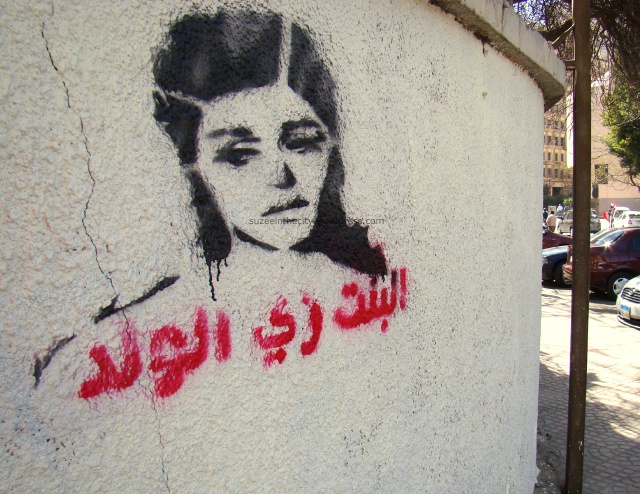
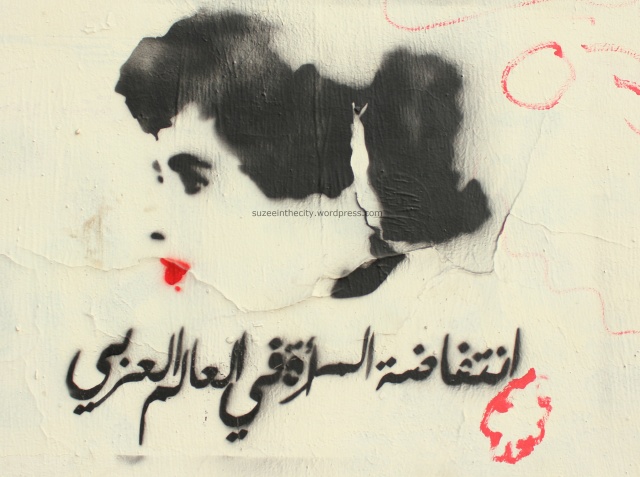
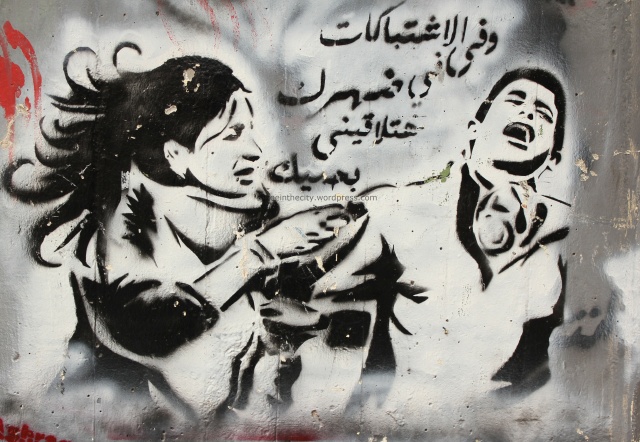
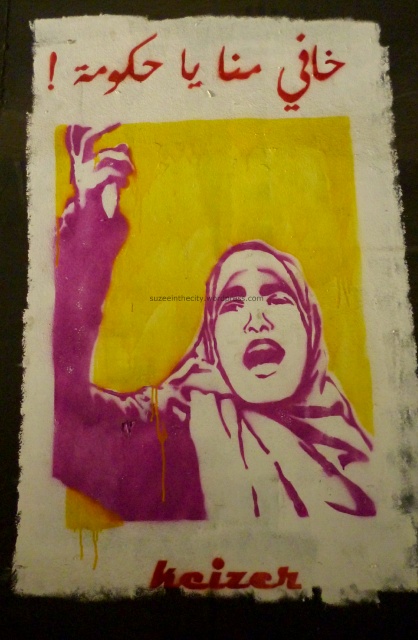
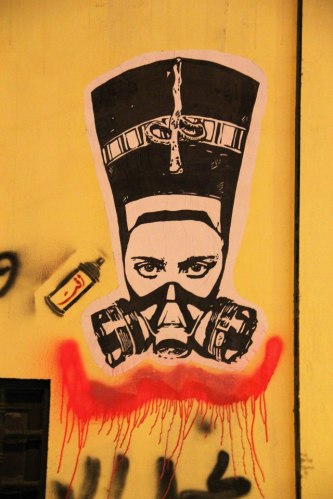

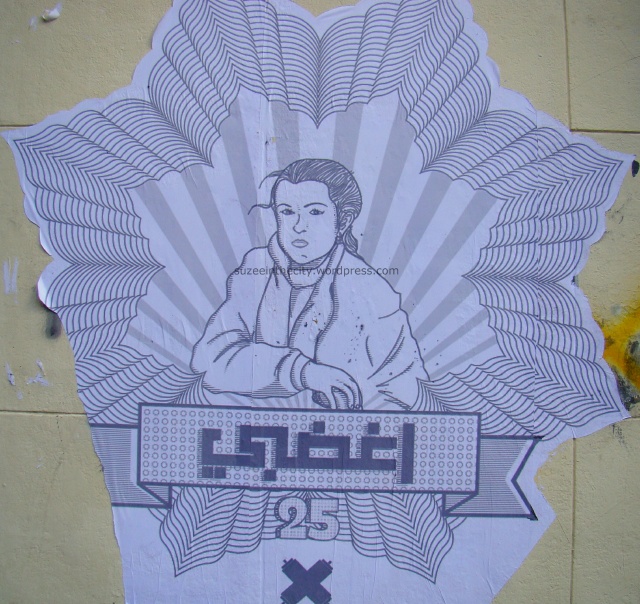
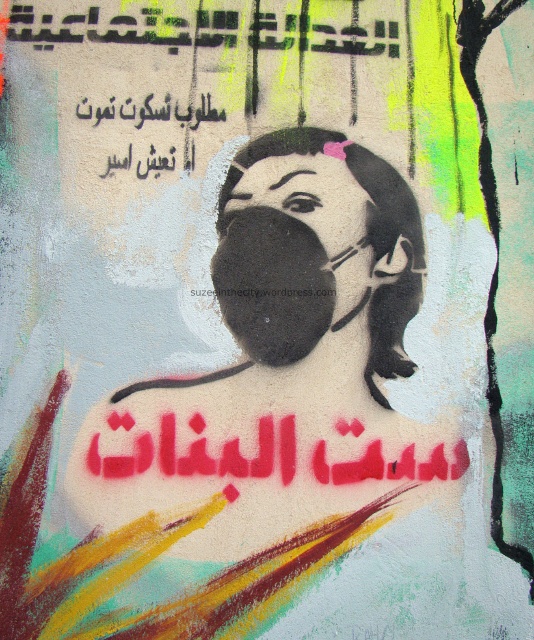
This is just amazing… Bravo… Great post!
this takes my breath away, so stunning. Bro Russell
Pingback: Something New Under the Sun
Great post!
Excellent stuff. Thanks very much for posting this. 🙂
Incredible! Thanks for sharing this.
Excellent post and inspirational women! Yes, the women of Egypt are not sitting home quietly accepting oppression neither by the system or by the patriarchy, meekly awaiting liberation…
I wrote a short post about how we are told that women “over there” (these women being us supposedly needing outside help to be liberated…) – would love it if you had a look.
Keep going strong! 🙂
bravo! read your post! i agree completely!
hello Suzee, my daughter is a journalist in Delhi , India , she wants to write a story abt graffiti art and many other issues of Egypt. I live in Zamalek, would it be possible that we meet some day?Thanks, Brinda
Can you send me your contact info on s.aboubakr@thedailynewsegypt.com?
Boooooooooooooring! Desperation is an ugly thing,whats next? A selection of sexual harassment,Anti SCAF,Anti Mubarak pieces by street artists ,grouped up and turned it into an exclusive post and saluting them. Its all out there for everyone to see,instead of putting them out when they were fresh and new,your attempting to create a category by grouping up very old stencils and turning them into what seems a hot and new topic.Barf.
Thank you, ahmed. How about you stop wasting your precious time commenting on desperate, ugly people’s blogs? Surely you have something better to do.
Ahmed, it’s all about context.. old stencils or not, the plight of women in Egypt has been shadowed for decades. The Arab Spring has brought a lot more focus to the issue, and this article visits the subject in an interesting, unconventional way!
truly interesting, you talk my breath away ….. such an exciting and valuable post indeed ….
I mean you took my breath away 🙂
great to find all this wonderful graffiti art here, thank you. 🙂
i think Samira Ibrahim and Aliaa el Mahdy are BOTH heroes! Samira’s case *did* receive a lot of media coverage (and sadly, associated death threats). going public is part of her bravery.
i dont like the idea of dividing women into ‘sweet innocent victims’ who then stood up for their rights, versus those who pro-actively tried to take their rights via shock tactics. it speaks to me too much of praising ‘good girls’ and punishing ‘bad’ ones.
Samira Ibrahim’s fight against the authorities and the idea that sexual assault stigmatises the victim was brave and very necessary. Aliaa el Mahdy’s protest was brave and very necessary in the crushing climate we have here of defining us by the ‘modesty’ of our clothing and apparent virtue.
I agree, i’m quite annoyed that this article implies that what she did was any less brave or that it was worthless. Maybe i’m just being paranoid because of all the negative comments I saw about her which I thought were just plain unfair and narrow minded, and I hate to feel like even those whose side she is on are in any way denouncing her actions or belittling them.
Apart from that great article and great pictures. Kudos.
I love your post! I live in Utah, USA. I am an artist and loved this art!
Wonderful pieces and highly inspiring – thank you for posting them!! Though I’m an American, I used to live in Egypt when I was younger and I love street art, so this post was perfect for me =)
Brilliant !
Excellent!
A brilliant piece! I truly enjoyed it and have tweeted and facebooked it
I live abroad and regardless of whether old or not as per disappearing Ahmed’s comments, it was powerful to see it all in one place. The blog gave it substance, content, energy and unity. Thank you for that. Keep me in the loop 🙂
Reblogged this on Transhumanisten.
Re Ammar Abo Bakr’s touching tribute to Samia Ibrahim versus Alia El Mahdy, I can’t read the Arabic. Is the “versus” meaning he is comparing the righteousness of the two? Is there a criticism of Alia El Mahdy?
Great work, so good to see women’s public art as protest.
As someone who used to love walking in downtown cairo and zamalek streets, but has post-revolution become intimidated by the idea of putting myself at risk of sexual harrasment, this articles gives me a visual of the revolutionary art on cairo’s streets that I’ve missed due to fear. It’s empowering and I hope I get to see them in real life. Thanks!
Thanx for this post, it’s really good. I just have one comment: the women who give their graf work to the people by putting it on the walls don’t threaten to hurt anyone who shares it… so why do you? It would be nicer if you said something like “if you use any of my photos, please link back to this blog / give me credit.”
Hi shiva, this statement was made after discovering that people have taken my photos and made financial profit out of, claiming they didn’t understand that my watermarked photos prevented them from doing so. I’ve had no problem with others using my photos but I don’t like being exploited. Thanks
Reblogged this on Contemporary artist Jacqueline van der Venne and commented:
It’s a battle, being a woman in an Arab country
THIS IS AMAZING AND INSPIRING
Pingback: EGYPT: Women in Graffiti: A Tribute to the Women of Egypt « Tahrir-ICN
Respect!Such an amazing gallery 🙂
Indeed we owe the Egyptian Women so much
Hey there.. I need to contact you asap. I produce a magazine. And I think you input would be a great addition to it..
Please Email me asap
Pingback: Haunts: Tahrir meant liberation. It still does. Ask the women – women in and beyond the global
Reblogged this on aileencarson and commented:
Awesome.
Great piece of writing and great to see women being brought to the forefront. Amazing pics. Thank you very much…
What a fantastic collection of images and ideas, and a great two-fingered-salute to all the stereotypes of Arab women peddled by the Western media. Brilliant.
Was great to see you at the City Circle in London the presentation was excellent. I felt you successfully conveyed the plight of the people in Egypt and the tremendous struggles women are having to endure in such a fluid political situation. Thankyou for expressing very important social and political issues that have been brought to light through the street art where the mainstream corporate press-titute media has failed. Their job is more of political distraction and smoke screening for their political masters , which is why your documentation of these amazing graffiti artists is so key for us to understand the true nature of the emotion the feeling the mood of the people as it seems that the only place where you can find it being transmitted the most is through the spray can rather than the scripted news presenter, i cannot stress how important your work is and I salute you in your documenting and writing about this issue. May your work gain more recognition that it already has, i have already posted your blog on my Facebook page, Your presentation was a fascinating journey from understanding your relationship with the art itself to the creative output of the artists and their subject matter. The subject matter of many of the examples of work that you have been showing for me display a very Visceral form of expression something that the street art manages to convey powerfully. I feel as if i can smell the teargas from the strokes of paint or i can hear the agony from the expressions in the faces spray painted. The presentation reinforced by this blog has had a deep impact on me being an artist myself its helped me to realize that the universal language of hope and courage can be transmitted in the most darkest of situations through simple lines and textures on a wall. I would even argue that much of this work is an expression of human rights in its most purest form borne out of the tremendous highs and lows and trauma the country has suffered, enjoyed and endured. Whats so exciting about the graffiti emerging from the middle east and Egypt in particular is that seems that whilst the situation Geo politically and militarily is in a state of flux and fluidity there seems to be no limitations in terms of the style or method to the street art in fact by its very nature having been created in an environment of extremes it seem the art has taken on a much more experimental, fresh and edgy nature something that i believe many street artists in the west have been lacking due to being too comfortable dare i say in their own social environment perhaps even diluting the whole essence of street art as being a form of political anti establishment speech into conforming to a more consumerist graffiti that lends itself more to the fashion industry and celebrity culture than to the victims of war crimes and oppression, thus it seems western graffiti could be argued is conforming to repetitive styles and themes by their own local peers thus losing the real ethos of what street art really means , this is where the street art from Egypt and around the middle east is a massive wake up call a massive jolt of reality , shaking us back to basics where street art first emerged, The pieces you showed us in the presentation and the many more here on this blog is graffiti in its rawest sense undiluted and powerful in its message enough to make you cry. For me it says here’s where the real shit is at. This i find very interesting as i believe us street artists in the west are sitting up and taking note and if any are not then they should since ironically the styles and themes of street art from the middle east may well be repeated in the west soon due to the increased economic austerity and militarization of society through draconian anti terrorism legislation, erosion of civil liberties and a increased police state control grid emerging as a result of a possible economic/financial collapse in the west, What we are witnessing could again be the Tarir Square effect that was the spiritual backbone that launched the Occupy wall street movement but in an artistic fashion. This art is as important to us here in the west as it is in Egypt and elsewhere in the middle east as its at the epicenter of where humanity is fighting tyranny. God bless you and god bless the artists may you all continue the good work you are doing , my prayers are with you always,
Thankyou for highlighting so many important issues and the powerful way the street art qas questioning the issue of women in society and gender equality issues these issues resonate with us globally and we stand with you in solidarity may they all gain the justice they deserve
Your brother Imran
I have just profiled Samira Ibrahim as Extraordinary
Meet the Extraordinary Samira Ibrahim, women’s right activist in Egypt.
One of the most powerful and influential voices today in the area of women’s rights.
She rose to prominence after filing a case in the Egyptian court against the military personnel for violating her and other women’s rights after being arrested for joining the 2011 Egyptian Revolution that ousted the then sitting President Hosni Mubarak.
“Egyptian women are the secret of the revolution.”. Samira Ibrahim
For more of Samira’s Inspiring quotes, biography, video and more visit:
http://www.thextraordinary.org/samira-ibrahim#why-samira-ibrahim-is-extraordinary
“Helping You Everyday To Be Extraordinary!”
Information with Inspiration
Brilliant read and what inspiring women. Thanks for posting this 🙂
Pingback: Egyptian Graffiti and Gender Politics: An Interview with Soraya Moreyef – Africa is a Country
Reblogged this on My Egyptian Intermezzo and commented:
I really do like this: the Arab Spring did not mean awakening of Arab women because they woke up long time ago. You are amazing – Egyptian women!
Gr8 and wonderful article Petra, thanks for sharing it, the pictures and the material that you wrote about are so inspiring, I saw some people herassment in Tahrir square so I shouted out and said : we are here to fight for our freedom so how come we don’t give ladies and women their freedom !! I just hope my country will change to the better starting with the behaviour and education.
Pingback: Feminist Street Art in the Egyptian Uprising | womanstats
Pingback: Sprühende Wut – Straßenkunst in Ägypten | Böhms Logbuch
Pingback: Women in Graffiti: A Tribute to the Women of Egypt | suzeeinthecity | Travel with Intent
Fascinating post. Some incredible work. Reblogged at http://travelwithintent.com/2013/07/16/women-in-graffiti-egypt/
Pingback: The Feminist Graffiti Of The Egyptian Revolution
Pingback: Belal Ali Saber: Graffiti by Ammar Abo Bakr and El Zeft | suzeeinthecity
Pingback: Egypt and the Sexual Harassment of Women | The Travelling Chain Bike Massacre
Pingback: Women in Graffiti: A Tribute to the Women of Egypt | EVS NOTÍCIAS.
Pingback: Women in Graffiti: A Tribute to the Women of Egypt | 694028 NEWS
Pingback: Aleid Landeweerd» Blog Archive » Echt nieuws staat op de muur
Pingback: 6 Amazing Urban Artists That Deserve Your Attention | Cheeky Jaunt
Reblogged this on Veils.
Pingback: Documenting Graffiti Art: DNT | Art vS Graffiti
Great!
Pingback: Hanaa El Degham |
Reblogged this on Welcome to OSTrigg's Blog….
Pingback: Frauen in ägyptischen Graffitis | -=daMax=-
Pingback: Egyptian Graffiti and Gender Politics: An Interview with Soraya Morayef | Mona Baker
Pingback: Women in Graffiti: A Tribute to the Women of Egypt | suzeeinthecity | andyzootie
Pingback: 5 artistas en Egipto que te harán salir a la calle – Va de arte!
Pingback: focusedfeminism